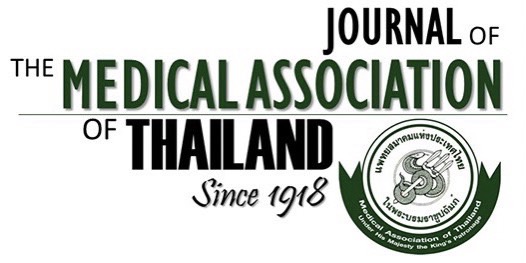Efficacy of Balloon Angioplasty to Correct Intragraft Stenosis during the Surgical Revision of Thrombosed Dialysis Graft: A Prospective Randomized Controlled Trial
Supachai Chanvitan MD*, Suthas Horsirimanont MD*, Sopon Jirasiritum MD*, Surasak Leela-Udomlipi MD*, Piyanut Pootracool MD*, Nutsiri Kittitirapong MD*, Sakda Arj-Ong Vallibhakara MD, PhD**, Wiwat Tirapanich MD*
Affiliation : * Division of Vascular Surgery and Transplantation, Ramathibodi Hospital, Mahidol University, Bangkok, Thailand. ** Section for Clinical Epidemiology and Biostatistics, Ramathibodi Hospital, Mahidol University, Bangkok, Thailand
Background : Intragraft stenosis is luminal narrowing of prosthetic AV graft for hemodialysis remote from the vascular anasto-
moses and is related to the development of peri-graft scar and fibroblastic in growth through needle puncture tracts at the access
cannulation sites. If intragraft stenosis is not detected and correct during surgical revision of acutely thromboses AV graft it will
lead to early rethrombosis
Objective : To compare between surgical revision with adjunctive balloon angioplasty on intragraft stenosis (intervention group)
and surgical revision alone (control group) in post-intervention primary patency rate, the efficacy of balloon angioplasty on
intragraft stenosis and incidence of intragraft stenosis in thrombosed dialysis graft.
Material and Method: Between March 2016 and January 2017, All thrombosed dialysis graft patients at Ramathibodi Hospital
were analyzed (n = 104). Grafts created less than 3 months or more than 2 years, a graft with infection, contrast allergy, and
surgical revision more than twice were excluded. Forty-two patients were enrolled and randomly assigned to control and
intervention group. All patients underwent surgical revision and intraoperative fistulography. Adjunctive balloon angioplasty was
performed in the intervention group if intragraft stenosis with 50% or greater luminal narrowing was detected. Patency rates were
estimated by Kaplan-Meier survival analysis.
Results : The two groups exhibited similar demographic features and comorbidities (p>0.05). A median follow-up time is 124
days (95% CI 126 to 291). No significant difference in overall post-intervention primary patency rate between the two groups (p
= 0.973), at 3-month follow-up of control group [75% (95% CI 0.57 to 0.86)] and intervention group [78% (95% CI 0.61 to
0.88)]. And at 6-month follow-up of control group [62% (95% CI 0.43 to 0.76)] and intervention group [58% (95% CI 0.38 to
0.73)]. In subgroup analysis of patients who had intragraft stenosis, the post-intervention primary patency rate of the intervention
group was higher than in the control group (p = 0.009). At 3-month follow-up of control group [62% (95% CI 0.23 to 0.86)] and
intervention group [87% (95% CI 0.38 to 0.98)]. And at 6-month follow-up of the control group [0%] and the intervention group
[31% (95% CI 0.04 to 0.64)]. Anatomic success rate after balloon angioplasty was 100%. The incidence of intragraft stenosis was
28.5% (12/42).
Conclusions: Incidence of intragraft stenosis was 28.5% and could be effectively corrected by balloon angioplasty, therefore
resulting in prolonged vascular access function.
Keywords : Thrombosed grafts, Prosthetic arteriovenous graft, Thrombosed prosthetic hemodialysis grafts, Balloon angioplasty, Intragraft stenosis



